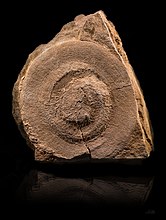Eldonia
| Eldonia Temporal range:
| |
|---|---|

| |
| Eldonia ludwigii from the middle Cambrian Burgess Shale. | |

| |
| Life restoration | |
| Scientific classification | |
| Domain: | Eukaryota |
| Kingdom: | Animalia |
| Superphylum: | Deuterostomia |
| Stem group: | Ambulacraria |
| Clade: | †Cambroernida |
| Family: | †Eldoniidae |
| Genus: | †Eldonia |
| Species | |
| |
| Synonyms | |
Eldonia is an extinct soft-bodied cambroernid animal of unknown affinity,[3] best known from the Fossil Ridge outcrops of the Burgess Shale, particularly in the 'Great Eldonia layer' in the Walcott Quarry.[4] In addition to the 550 collected by Walcott,[5] 224 specimens of Eldonia are known from the Greater Phyllopod bed, where they comprise 0.43% of the community.[6] Species also occur in the Chengjiang biota,[2] Siberia,[7] and in Upper Ordovician strata of Morocco.
A specimen from the Lower Ordovician Madaoyu Formation in Hunan, South China, can be interpreted as the incomplete body of Eldonia or the similar animal. However, its annulation, the structure of the intestine and the shape of the body are more similar to those of Ottoia.[8]
Description[edit]
It takes the form of a round, medusoid disk (which originally led to suggestions of a jellyfish affinity)[9] with a C-shaped gut trace. The gut is recalcitrant and can be extracted using Hydrofluoric acid.[10]
Classification[edit]
Walcott's original interpretation as a holothurian was rapidly disputed.[11] Alternative affinities to be suggested, which did not stand the test of time, included the siphonophores[12][13][14] and a coelenterate medusa.[15]
The eldoniids form a clade that also includes Paropsonema, Rotadiscus, and Stellostomites.[16]
Paleoecology[edit]
The organism is frequently found in association with the lobopod Microdictyon, which is presumed to have fed on Eldonia.[17]
-
Eldonia berbera
-
Eldonia ludwigii, Walcott Quarry. About 4 cm long
See also[edit]
References[edit]
- ^ ALESSANDRELLO Anna; A BRACCHI Giacomo (2003). "Eldonia berbera n. sp., a new species of the enigmatic genus Eldonia Walcott, 1911 from the Rawtheyan (Upper Ordovician) of little Atlas (Erfoud, Tafilalt, Morocco)". Atti della Società Italiana di Scienze Naturali e del Museo Civico di Storia Naturale in Milano. 144 (2). Milano, ITALIE: 337–358. ISSN 0037-8844.
- ^ a b c CHEN, J-Y.; M-Y. ZHU; G. Q. ZHOU (1995). "The early Cambrian medusiform metazoan Eldonia from the Chengjiang Lagerstätte" (PDF). Acta Palaeontologica Polonica. 40: 213–244.
- ^ Signor, P. W.; Vermeij, G. J. (1 July 1994). "The Plankton and the Benthos: Origins and Early History of an Evolving Relationship". Paleobiology. 20 (3): 259–406. Bibcode:1994Pbio...20..297S. doi:10.1017/s0094837300012793. ISSN 0094-8373. JSTOR 2401005. S2CID 87094600.
- ^ Gabbott, S. E.; Zalasiewicz, J.; Collins, D. (2008). "Sedimentation of the Phyllopod Bed within the Cambrian Burgess Shale Formation of British Columbia". Journal of the Geological Society. 165 (1): 307–318. Bibcode:2008JGSoc.165..307G. doi:10.1144/0016-76492007-023. S2CID 128685811.
- ^ Durham, J. W. (1974). "Systematic Position of Eldonia ludwigi Walcott". Journal of Paleontology. 48 (4): 750–755. Bibcode:1974JPal...48..524M. JSTOR 1303225.
- ^ Caron, Jean-Bernard; Jackson, Donald A. (October 2006). "Taphonomy of the Greater Phyllopod Bed community, Burgess Shale". PALAIOS. 21 (5): 451–65. Bibcode:2006Palai..21..451C. doi:10.2110/palo.2003.P05-070R. JSTOR 20173022. S2CID 53646959.
- ^ D. Friend; A. Yu. Zhuravlev & I. A. Solov’ev (2002). "Middle Cambrian Eldonia from the Siberian Platform". Paleontological Journal. 36 (1): 20–24. Archived from the original on 2016-03-03.
- ^ Xiang Fang, Yingyan Mao, Qi Liu, Wenwei Yuan, Zhongyang Chen, Rongchang Wu, Lixia Li, Yuchen Zhang, Junye Ma, Wenhui Wang, Renbin Zhan, Shanchi Peng, Yuandong Zhang, Diying Huang (2022). "The Liexi fauna: a new Lagerstätte from the Lower Ordovician of South China". Proceedings of the Royal Society B. 289 (1978): 1—8. doi:10.1098/rspb.2022.1027.
{{cite journal}}: CS1 maint: multiple names: authors list (link) - ^ Jun-yuan, C.; Mao-yan, Z.; Gui-qing, Z.; Signogneau-russell, D.; Hahn, R.; Koz{l}owska-dawidziuk, A.; Stefaniak, K. (1995), "The Early Cambrian medusiform metazoan Eldonia from the Chenjiang Lagerstätte" (PDF), Acta Palaeontologica Polonica, 40 (3): 213–244, retrieved 2009-08-12
- ^ Butterfield, N. J. (1 July 1990). "Organic Preservation of Non-Mineralizing Organisms and the Taphonomy of the Burgess Shale". Paleobiology. 16 (3): 247–399. Bibcode:1990Pbio...16..272B. doi:10.1017/s0094837300009994. ISSN 0094-8373. JSTOR 2400788. S2CID 133486523.
- ^ Clark, H. L. (1912). "Fossil Holothurians". Science. 35 (894): 274–278. doi:10.1126/science.35.894.274-a. JSTOR 1638409. PMID 17809248.
- ^ Madsen, F. J. (1957). "On Walcott's Supposed Cambrian Holothurians". Journal of Paleontology. 31 (1): 281–282. Bibcode:1974JPal...48..524M. JSTOR 1300523.
- ^ MADSEN, F. J. (1962). "The systematic position of the Middle Cambrian fossil Eldonia" (PDF). Medd. Dan. Geol. Foren. 15: 87–89.
- ^ MADSEN, F. J. (1956). "Eldonia, a Cambrian Siphonophore-formerly interpreted as a Holoturian[sic]". Videnskabelige Meddelelser Fra Dansk Naturhistorisk Forening I Københaven. 118: 7–14.
- ^ Lemche, Henning (1960). "A possible central place for Stenethecoides Resser, 1939 and Cambridium Horny, 1957 (Mollusca Monoplacophora) in invertebrate phylogeny". Rep. Int. Geol. Congr. XXI Session, Norden (Pt. 22): 92–101.
- ^ Caron, J.; Conway Morris, S.; Shu, D.; Soares, D. (2010). Soares, Daphne (ed.). "Tentaculate fossils from the Cambrian of Canada (British Columbia) and China (Yunnan) interpreted as primitive deuterostomes". PLOS ONE. 5 (3): e9586. Bibcode:2010PLoSO...5.9586C. doi:10.1371/journal.pone.0009586. PMC 2833208. PMID 20221405.
- ^ Zhang, X-G; Hou, X-G (Dec 2007). "Gravitational Constraints on the Burial of Chengjiang Fossils". PALAIOS (Submitted manuscript). 22 (6): 513–518. Bibcode:2007Palai..22..448Z. doi:10.2110/palo.2006.p06-085r. ISSN 0172-4622. S2CID 128830203.
External links[edit]
- "Eldonia ludwigi". Burgess Shale Fossil Gallery. Virtual Museum of Canada. 2011. Archived from the original on 2020-11-12.


